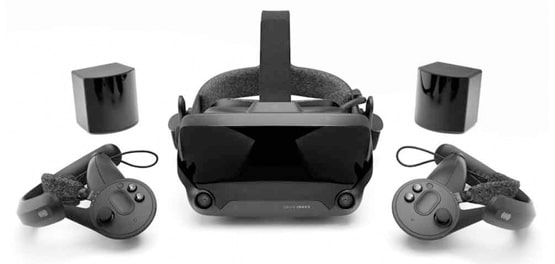Resolution per eye
1600 x 1440 px
Density per eye ⓘⓘ Pixel Density relativized to 6 inch for better comparison
359 ppi
Field of View
130°
Display Refresh Rate
144 Hz
Display Technology
Dual LCD Full RGB Pixel
Standalone
No
Tracking
6DOF - Base Stations
Weight
809 g
Released
2019
Platform
Steam VR
When we heard about the Valve Index, we just thought it would be some kind of HTC Vive successor. It was rather surprising that it would be such a strong successor. A strong starting price of around € 1000 is of course a bit considerable. But the high viewing angle of 130 ° and the controllers that track individual fingers are only a small glimpse into the strengths of the Valve Index.
Valve has set the bar very high with its “Valve Index” VR Headset. 130 ° viewing angle, 120 Hz (144 possible) and hand controllers that recognize individual fingers. A new half life. Is this the breakthrough for VR headsets and VR games?

When we heard about the Valve Index, we just thought it would be some kind of HTC Vive successor. It was rather surprising that it would be such a strong successor. A strong starting price of around € 1000 is of course a bit considerable. But the high viewing angle of 130 ° and the controllers that track individual fingers are only a small glimpse into the strengths of the Valve Index.
Check out this test video to learn more:
Display:
Resolution: 1440 x 1600 pixels per eye
Display technology: LCD
Viewing angle: 130 °
Refresh rate: 120 Hz (up to 144 Hz)
Audio : Headphone
Tracking : 6DOF, at least 2 base stations required
Weight: 809 grams
Why LCD and no OLED at Valve Index?
What bothers most about VR is the “fly screen” that is created when the resolution is too low. The Valve Index has 1440 x 1600 pixels per eye. At this resolution, individual pixels can almost no longer be recognized. But there are big differences between LCD and OLED. OLED definitely has the advantage that the contrasts, especially in the black area, are really black. Nevertheless, even at high resolutions and “grids” can be perceived, that is, as if looking through a mosquito net.
LCD, on the other hand, has more subpixels, which ensures an overall sharper image. Valve opted for the LCD variant here. At some point you get used to the fact that black is not 100% black, especially if you only have the display in front of your eyes. It is different with a television, where you can see very clearly that black is not black, especially in the evening when it is dark in your room.
Up to 144 Hz frame rate
There were times when you thought 30 Hz was enough to see a smooth picture. Many films are still played at 30 Hz or 24 Hz (fps). Then you switched to 60 Hz – the difference is enormous. But there is always more. Even the difference between 90 Hz and 120 Hz is extremely noticeable.
The Valve Index runs on 120 Hz by default, but is backwards compatible to 90 Hz and can even be used with up to 144 Hz. You should definitely own a powerful gaming PC if you want to achieve 144 Hz. But if you make it to 144 Hz, you have the most real VR experience that has ever existed.
The reaction time (afterglow or after-glow effect) is only 0.4 ms. This means that the image (almost) does not blur with fast movements. In contrast to z. B. That is extremely few smartphones, so you should choose AMOLED for smartphones for VR. AMOLED is extremely fast by default, but you will always be able to see a pixel network, which is not the case with LCD. This is probably why the Valve Index opted for LCD.
Tracking
The Valve Index is compatible with the base station of the SteamVR 1.0 and 2.0. So if you own an HTC Vive and have the tracking base stations, you don’t necessarily have to use the new tracking stations.
New half-life
Valve also brings an incredible game with the Valve Index. Half-Life: Alyx
Valve Index successor
As of May 2021: At the moment there are only rumors about a Valve Index successor VR Headset and no official confirmation yet. But after the Valve Index was very successful, caused a sensation and a high gain in users in VR, one can assume that a Valve Index successor is already in development. Maybe Valve could be inspired by the features of the Meta Quest / Oculus Quest and Meta Quest / Oculus Quest 2 that have made these VR glasses the best-selling ones: tracking without base stations, light weight and a self-sufficient system (stand alone) . A Valve Index 2 could likely be presented in late 2021 or early 2022. Although the price of the Valve Index for end consumers is relatively high (approx. € 1000 with base stations and controllers), this VR headset was sold extremely often. Therefore, the price would probably be in the same price range again.
